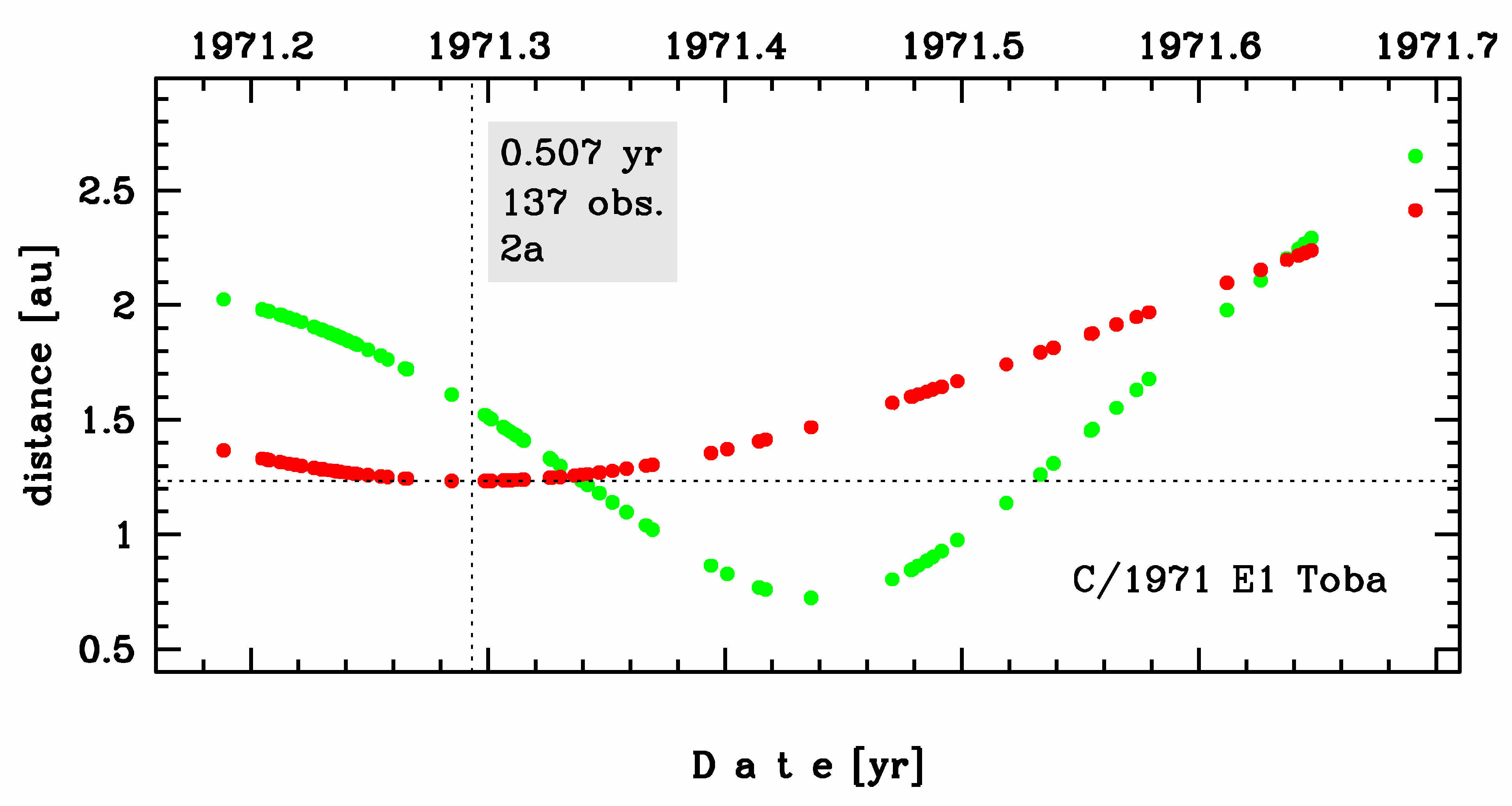C/1971 E1 Toba
more info
Comet C/1971 E1 was discovered on 7 March 1971 by Kenji Toba (Tsuchiura, Ibaraki, Japan), that is more than a month before its perihelion passage. It was observed until 9 September 1971 [Kronk, Cometography: Volume 5].
Comet had its closest approach to the Earth on 9 June 1971 (0.724 au), about a month and 3 weeks after its perihelion passage.
Solutions given here are based on data spanning over 0.504 yr in a range of heliocentric distances: 1.37 au – 1.233 au (perihelion) – 2.41 au.
This comet suffers moderate planetary perturbations during its passage through the planetary system; according to preferred solution these perturbations lead to escape the comet from the planetary zone on a hyperbolic orbit (see future barycentric orbits).
See also Królikowska 2020.
Comet had its closest approach to the Earth on 9 June 1971 (0.724 au), about a month and 3 weeks after its perihelion passage.
Solutions given here are based on data spanning over 0.504 yr in a range of heliocentric distances: 1.37 au – 1.233 au (perihelion) – 2.41 au.
This comet suffers moderate planetary perturbations during its passage through the planetary system; according to preferred solution these perturbations lead to escape the comet from the planetary zone on a hyperbolic orbit (see future barycentric orbits).
See also Królikowska 2020.
| solution description | ||
|---|---|---|
| number of observations | 137 | |
| data interval | 1971 03 09 – 1971 09 09 | |
| data type | perihelion within the observation arc (FULL) | |
| data arc selection | entire data set (STD) | |
| range of heliocentric distances | 1.37 au – 1.23 au (perihelion) – 2.41 au | |
| type of model of motion | NS - non-gravitational orbits for standard g(r) | |
| data weighting | YES | |
| number of residuals | 275 | |
| RMS [arcseconds] | 1.22 | |
| orbit quality class | 2b | |
| previous orbit statistics, both Galactic and stellar perturbations were taken into account | ||
|---|---|---|
| no. of returning VCs in the swarm | 3622 | * |
| no. of escaping VCs in the swarm | 1379 | |
| no. of hyperbolas among escaping VCs in the swarm | 1355 | |
| previous reciprocal semi-major axis [10-6 au-1] | -711.82 – 647.40 – 1,997.61 | |
| previous perihelion distance [au] | 1.2299 – 1.2316 – 1.2318 | R |
| previous aphelion distance [103 au] | 0.91 – 1.9 – 9 | |
| time interval to previous perihelion [Myr] | 0.0095 – 0.03 – 0.28 | R |
| percentage of VCs with qprev < 10 | 98 | |
| percentage of VCs with qprev > 20 | 2 | |
| previous_g orbit statistics, here only the Galactic tide has been included | ||
|---|---|---|
| no. of returning VCs in the swarm | 3617 | * |
| no. of escaping VCs in the swarm | 1384 | |
| no. of hyperbolas among escaping VCs in the swarm | 1355 | |
| previous reciprocal semi-major axis [10-6 au-1] | -711.83 – 647.40 – 1,997.61 | |
| previous perihelion distance [au] | 1.2303 – 1.2317 – 1.2318 | R |
| previous aphelion distance [103 au] | 0.91 – 1.9 – 9 | |
| time interval to previous perihelion [Myr] | 0.0095 – 0.029 – 0.28 | R |
| percentage of VCs with qprev < 10 | 100 | |
